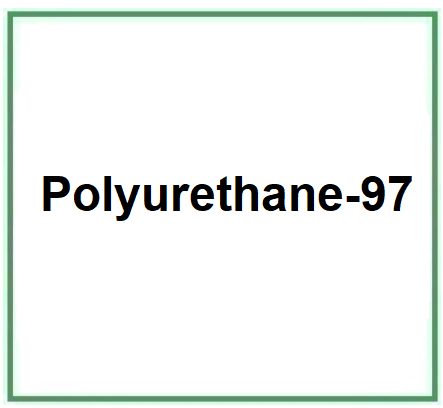Polyurethane-97 is an inorganic chemical compound, a segmented block copolymer derived from urethane and synthesised from isocyanates.
The name describes the structure of the molecule:
- "Polyurethane" is a term that describes a class of polymers widely used in various applications due to their versatility and desirable properties such as durability, flexibility and abrasion resistance and temperature variations.
- "-97" is a reference to the specific type or grade of polyurethane, which can be characterized by such factors as the types of isocyanates and polyols used, their relative amounts, and the presence of any additives. . This is a designation used to differentiate different molecular structures or variants of the polymer. In cosmetic chemistry, these numbers can help formulators identify specific characteristics or behaviors of a given ingredient, particularly when a chemical family has multiple derivatives or forms.
Significant substances used in the production method:
Dimethyl Carbonate, Hexanediol, Isophorone Diisocyanate, Hydroxyethyl Acrylamide, hydroxypropyl acrylamide, hydroxybutyl acrylamide.
Description of raw materials used in production with their functions.
- Dimethyl Carbonate. Solvent and methylation reagent.
- Hexanediol. Diol that provides hydroxyl groups for urethane bond formation.
- Isophorone Diisocyanate. Provides isocyanate groups for urethane bond formation.
- Hydroxyethyl Acrylamide. Monomer that introduces acrylate and hydroxyl groups into the structure.
- Hydroxypropyl Acrylamide. Provides additional acrylate and hydroxyl groups for the polymer network.
- Hydroxybutyl Acrylamide. Introduces flexibility into the polymer structure through acrylate and hydroxyl groups.
Step-by-step summary of industrial chemical synthesis process.
- React Isophorone Diisocyanate with Hexanediol to form a prepolymer with terminal isocyanate groups.
- Add Hydroxyethyl Acrylamide, Hydroxypropyl Acrylamide, and Hydroxybutyl Acrylamide to the prepolymer, allowing the hydroxyl groups to react with the terminal isocyanate groups.
- Further polymerization is initiated to form a polymer network with urethane and acrylate bonds.
What it is used for and where
Cosmetics
Binder agent. Ingredient that is used in cosmetic, food and pharmaceutical products as an anti-caking agent with the function of making the product in which it is incorporated silky, compact and homogenous. The binder, either natural such as mucilage, gums and starches or chemical, may be in the form of a powder or liquid.
Nail Conditioning agent. It is an agent that creates protection against harmful or chemical substances by strengthening the nail structure against external elements and can repair any chipping, cracking or brittle nails. It helps keep the nail's outer layer and keratin protein in good condition. It can also prevent cracking and peeling of the nail.
It appears as a white powder or colorless liquid.

Safety
Urethane (also called ethyl carbamate) is a by-product of fermentation and is considered a genotoxic agent.
Polyurethanes are rather complex, inert and biostable materials that are also used in biomedical applications. They are typically synthesised by the reaction of a glycol or polyol with polyisocyanate or diisocyanate. It is known that exposure to isocyanates can cause asthma, contact allergies, conjunctival and skin irritation. However, a study by the Cosmetic Ingredient Review Expert Panel in 2017 found that the rates of harmful residues are not significant for human health.
![]() Polyurethane-97
Polyurethane-97 


